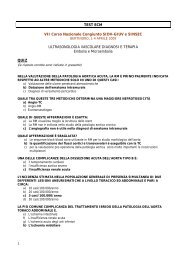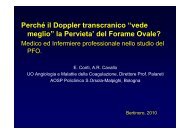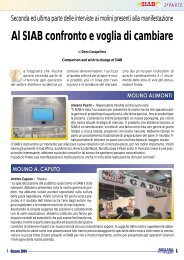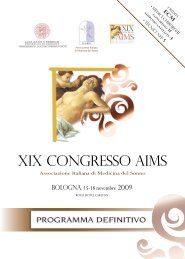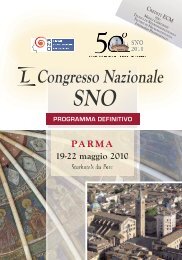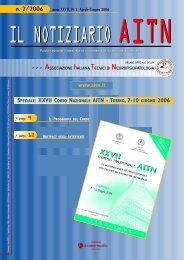MERCOLEDI' 5 OTTOBRE SALA C ORE 9 - Avenue media
MERCOLEDI' 5 OTTOBRE SALA C ORE 9 - Avenue media
MERCOLEDI' 5 OTTOBRE SALA C ORE 9 - Avenue media
You also want an ePaper? Increase the reach of your titles
YUMPU automatically turns print PDFs into web optimized ePapers that Google loves.
IL RUOLO DI CONTROLLO DEL TALAMO NELLA SALVAGUARDIA DEL SONNO:<br />
UN REPORT F-MR<br />
A Del Felice a , E Formaggio b , SF Storti a , A Fiaschi a,b , P Manganotti a,b<br />
a Department of Neurological, Neuropsychological, Morphological and Movement Sciences,<br />
Section of Neurology, University of Verona; b Department of Neurophysiology, IRCCS San<br />
Camillo, Venezia<br />
Objective: neuroimaging is an innovative technique to study brain functiong during sleep.<br />
Most data regard nuclear neuroimaging, and only recently the potentials of functional<br />
Magnetic Resonance (fMRI) have been applied. Materials and methods: during an fMRI<br />
recording acquired on a 3 T scanner (MAGNETOM Allegra, Siemens, Erlangen, Germany)<br />
with contemporary electrical stimulation at the right <strong>media</strong>n nerve at different frequencies<br />
(3 and 10 Hz), two subjects fell asleep during the 3Hz session, and woke up when the<br />
frequency was shifted to 10 Hz. Functional data were analyzed using BrainVoyager and<br />
activated voxels identified with a GLM approach. Results: During electrical stimulation,<br />
subjects reported falling asleep, and were not responsive to commands. While asleep,<br />
BOLD signal increase was evident in thalamus, ascending-reticular-system and<br />
cerebellum, while BOLD signal decrease was observed over the bilateral occipital<br />
(Brodman areas 18 and 19), temporal (41) and posterior parietal cortex (7), with a minor<br />
area in the supplementary motor (6) and motor cortex (4). During wake, BOLD signal<br />
increase was recognized in the controlateral supplementary motor area (6), contralateral<br />
primary somatosensory cortex (7), bilateral secondary somatosensory cortex (5), bilateral<br />
insula and cerebellum. Discussion and conclusion: We report the first cases of fMRI of<br />
spontaneously sleeping healthy subjects during somato-sensory stimulation. A dissociation<br />
of BOLD signal activation/deactivation emerges: increased metabolism in thalamus and<br />
ascending-reticular-activating-system versus a BOLD decrease in heteromodal associative<br />
cortex (visual, auditory, parietal, prefrontal). This may be a visual rendering of the<br />
―thalamic gating hypothesis ‖ of the sleeping brain. Reduced brain responsiveness during<br />
sleep depends on the disruption of signal transmission from the periphery to the cortex. As<br />
an integrating station of the sensitive pathways, the thalamus selects information to be<br />
projected or not to the pertinent cortices: in short, it protects the sleeping cortex. A limit of<br />
our data is the lack of EEG-coregistration. Sleep was recognized by the examiner and<br />
referred by subjects. Nonetheless, we can reliably belive the subjects fell asleep due to the<br />
activation-deactivation pattern congruent with previous data and the BOLD pattern<br />
mismatch between the wake/asleep scans.<br />
49






